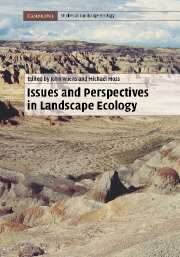Book contents
- Frontmatter
- Contents
- List of contributors
- Preface
- PART I Introductory perspectives
- PART II Theory, experiments, and models in landscape ecology
- 3 Theory in landscape ecology
- 4 Hierarchy theory and the landscape … level? or, Words do matter
- 5 Equilibrium versus non-equilibrium landscapes
- 6 Disturbances and landscapes: the little things count
- 7 Scale and an organism-centric focus for studying interspecific interactions in landscapes
- 8 The role of experiments in landscape ecology
- 9 Spatial modeling in landscape ecology
- 10 The promise of landscape modeling: successes, failures, and evolution
- PART III Landscape patterns
- PART IV Landscape dynamics on multiple scales
- PART V Applications of landscape ecology
- PART VI Cultural perspectives and landscape planning
- PART VII Retrospect and prospect
- Index
- Plate section
- References
6 - Disturbances and landscapes: the little things count
from PART II - Theory, experiments, and models in landscape ecology
Published online by Cambridge University Press: 20 November 2009
- Frontmatter
- Contents
- List of contributors
- Preface
- PART I Introductory perspectives
- PART II Theory, experiments, and models in landscape ecology
- 3 Theory in landscape ecology
- 4 Hierarchy theory and the landscape … level? or, Words do matter
- 5 Equilibrium versus non-equilibrium landscapes
- 6 Disturbances and landscapes: the little things count
- 7 Scale and an organism-centric focus for studying interspecific interactions in landscapes
- 8 The role of experiments in landscape ecology
- 9 Spatial modeling in landscape ecology
- 10 The promise of landscape modeling: successes, failures, and evolution
- PART III Landscape patterns
- PART IV Landscape dynamics on multiple scales
- PART V Applications of landscape ecology
- PART VI Cultural perspectives and landscape planning
- PART VII Retrospect and prospect
- Index
- Plate section
- References
Summary
Disturbances are events that significantly change patterns in the structure and function of landscape systems (Forman, 1995). These events and changes may be small to large, minor to catastrophic, natural to anthropogenic, and short-term to long-lasting. It is almost trite to say that disturbances are a ubiquitous component of all landscapes. Volumes and reviews have been written on landscape disturbances and responses (e.g., Pickett and White, 1985; Turner, 1987; Rundel et al., 1998; Gunderson, 2000), and some aspect of disturbance permeates most of the other papers in this volume.
Rather than attempt another general review of disturbance impacts on landscapes, which in a short paper could only be superficial, my aim here is to present a special perspective, one focused on a framework for how disturbances impact on small landscape structures (vegetation patches) and, consequently, on vital processes that occur at this fine scale. I will illustrate the way these impacts flow on to affect two landscape functions: conserving resources and maintaining diversity. It is these impacts and functions that are of growing interest to ecologists (e.g., McIntyre and Lavorel, 1994, 2001) and of critical importance to a wide spectrum of land managers, from ranchers with economic production goals to park rangers with biodiversity conservation goals (Freudenberger et al., 1997). I hope to convince you, with two examples, that understanding the effect of disturbances on basic landscape functions at a fine scale can lead to principles with much broader implications for both landscape preservation and restoration.
- Type
- Chapter
- Information
- Issues and Perspectives in Landscape Ecology , pp. 42 - 51Publisher: Cambridge University PressPrint publication year: 2005
References
- 4
- Cited by



